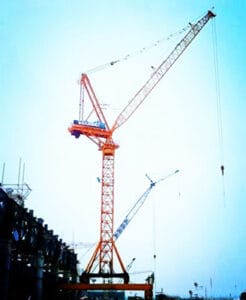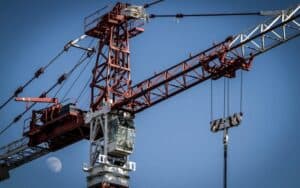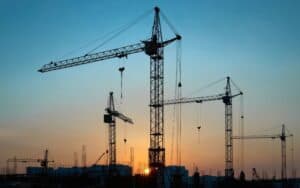A tower crane is a type of lifting machine commonly used in the construction of tall buildings and other large structures at heights productively, safely, and efficiently.
In the construction industry, there are three main types of tower cranes designed for different uses. This article will introduce you to the different types of cranes, their components, and discuss the advantages and disadvantages of the building to help you determine the best for your project.
Main Components of the Tower Crane
- Base/Foundation: A large concrete pad or foundation that supports the entire body of the crane and the whole weight of the entirestructure.
- Mast/Tower: The vertical tower or mast section that provides the crane with its height. It is made of steel sections bolted together and can reach hundreds of feet tall. The mast always has a triangular lattice structure, which helps the tower withstand powerful forces like wind or earthquake.
- Jib: The long horizontal arm that extends from the top of the tower. It carries the load and can be extended/retracted or angled as needed.
- Trolley: Runs along the jib to move the load inward/outward from the crane’s center.
- Hoist/Hook: The lifting mechanism with a hook, located at the end of the jib, that uses wire ropes and pulleys to raise/lower loads vertically.
Different Types of Tower Cranes
Mainly, there are four types of tower cranes: Hammerhead Cranes, Flat-top Tower Cranes, Luffing Jib Tower Cranes, and Self-erecting Tower Cranes.
Hammerhead Tower Crane
The hammerhead crane, also called gait cantilever, has a horizontal jib or boom arm connected to the top of a vertical tower. Its jib extends out on one side with a trolley that moves along it to position the hook and load. On the opposite side is a counterweight jib to balance the load on the main jib.
Hammerhead cranes are designed to handle extremely heavy loads, with some models able to lift over 100 tons. Because they are anchored to the ground, they offer exceptional stability to handle heavy lifting tasks safely. However, they are difficult to set up, and installation is a significant challenge for most users; typically, it needs a second crane to assist in assembling and disassembling the parts at construction sites.
The hammerhead crane is a versatile crane solution commonly recommended for construction projects and high-rise developments.
Flat-top tower crane
A flat-top tower crane is another type of tower crane used in construction projects. As the name suggests, it features a flat top without a separate horizontal jib like that of a hammerhead crane.
Instead of a distinct horizontal jib, the crane has a flat top structure where the trolley and hoist mechanisms are located. This design allows for a more compact crane with a smaller footprint.
The flat top structure rotates around the top of the mast using a slewing unit, enabling 360-degree rotation to cover the working area.
Flat-top cranes are generally easier and quicker to assemble and disassemble compared to hammerhead cranes due to their simpler design.
However, flat-top cranes typically have a lower lifting capacity compared to hammerhead cranes of similar size.
Luffing Jib Tower Crane
A luffing jib tower crane is a type of tower crane where the jib can be raised and lowered by the crane operator.
The main distinguishing feature of luffing jib tower cranes is that the latticed jib is hinged at the top of the tower, which gives the crane the ability to raise the jib to a near-vertical position or lower it horizontally. By luffing up the jib, the crane’s operating radius is reduced significantly, allowing luffing jibs to work in tighter spaces and congested urban sites with limited space.
The disadvantage of a luffing jib tower crane is that it can be more expensive than other cranes. However, we still recommend using it when your building site is in a small area or urban place.
Self-erecting Tower Cranes
A self-erecting tower crane, also known as a self-assembling or self-contained tower crane, is a type of crane designed to be easily transported and erected on a construction site without the need for an assisting crane.
Self-erecting tower cranes are designed to be disassembled into compact components that can be transported by truck or trailer to the job site. This allows them to be moved between sites relatively easily compared to larger tower cranes. They can be quickly set up in just 1-2 days, and the internal jacking system can raise them from the ground up without requiring another crane.
Typically, compared with other types of cranes, self-erecting tower crane has a smaller size, which allows them to operate in tighter job sites with limited space.
Self-erectors are commonly used for smaller construction projects, such as residential buildings, renovations, bridge work, etc. However, their lower capacities make them unsuitable for large high-rise or infrastructure projects.
The Advantages of Tower Cranes

Here are the key advantages of tower cranes:
- Lifting Capacity: Tower cranes exceed the loading and lifting capacity of any other type of crane and can lift extremely heavy loads. This makes them suitable for lifting massive construction materials like concrete, steel beams, and prefabricated components. They can reach heights unmatched by other cranes.
- Precision Placement: The horizontal jib of tower cranes enables accurate positioning and controlled placement of materials during construction. This accuracy is crucial for assembling complex structures and high-rise buildings.
- Efficiency and Cost Savings: Tower cranes can significantly improve construction efficiency by reducing the need for manual labor and multiple pieces of material handling equipment. Their ability to lift and place materials directly at the required location minimizes the need for workers to move materials repeatedly, saving time and labor costs. The use of tower cranes can lead to shortened project completion times, often by 15% or more.
- Environmental Benefits: Many modern tower cranes are electric or hybrid-powered, producing zero or reduced emissions at the construction site compared to diesel-powered equipment. This contributes to a greener and more sustainable construction process.
How to Choose the Best Tower Crane for Your Needs

Here are the key factors to consider when choosing the best tower crane for your needs:
- Lifting Capacity: Determine the weight of the heaviest loads you need to lift and how high you want to go. The crane must have sufficient capacity to safely handle your maximum loads. The crane’s jib length must be sufficient to provide adequate vertical reach.The tower crane you choose must provide sufficient vertical reach. For tall buildings, a climbing crane may be necessary to increase height as construction progresses.
- Assembly and disassembly: Factor in the time, cost and logistics of erecting and dismantling the crane, which includes foundation work. Assess mobile crane access to the site for assisting with setup and removal.
- Cost and Budget: Compare the total costs of different options, including rental/purchase, transportation, assembly, foundations, climbing, maintenance, etc.
For more personalized or up-to-date advice on selecting a tower crane, do not hesitate to contact IHURMO’s specialists. We are capable of pinpointing all relevant requirements.
Frequently Asked Questions
What are the main benefits of using a tower crane in construction projects?
Your construction projects can achieve remarkable efficiency with tower cranes as they offer superior lifting capacity and reach, enabling you to lift heavy materials to great heights. Their sturdy mast and well-balanced jib system enable safe and precise load maneuvering.
How do tower cranes improve efficiency on construction sites?
Tower cranes streamline the construction process by quickly and effectively moving large loads vertically and horizontally across the site, reducing the reliance on ground-based transportation and minimizing downtime.
What makes tower cranes a preferred choice for vertical construction?
In vertical construction projects, the height and reach of tower cranes make them invaluable for moving materials to high-rise areas that other cranes cannot easily access. They’re designed to climb the building as it rises, ensuring ongoing efficacy.
In what ways do tower cranes contribute to safety on job sites?
Tower cranes reduce safety risks on your job sites by providing remote control operations, which help maintain a safe distance from heavy loads. They also have built-in safety mechanisms and adhere to strict safety standards that enhance overall site safety.
Can you explain the unique advantages of tower cranes in urban construction?
In your urban construction, tower cranes provide a compact footprint, which is essential for sites with limited space. Their vertical design minimizes interference with city traffic and nearby structures, making them ideal for densely populated areas.
How does the height of a tower crane impact its operational benefits?
The towering height of a tower crane provides your project with advantage of reaching and servicing a vast area from a single fixed point, facilitating the movement and placement of loads at almost any point within the crane’s radius, which improves the overall productivity of construction work.






